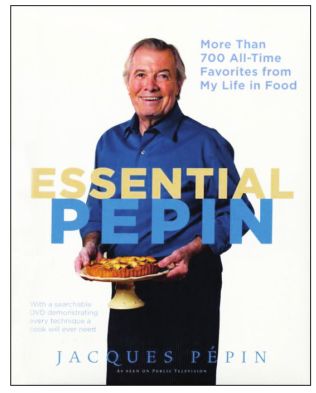
FOOD | Julianne Glatz
Books always constitute a significant proportion of the gifts under our Christmas tree.
And since most of my family members are enthusiastic cooks, it’s a safe bet that some of those books will be cookbooks. Here are two cookbooks on my Christmas shopping list this year. I’ve found both valuable – even invaluable – much more than just recipe collections.
Essential Pepin is Jacques Pépin’s 26th book. It contains more than 700 of his alltime favorites and is the companion book to Pépin’s current PBS cooking show. Most of the recipes reflect Pépin’s French background, although there are many others, such as several for making pizzas with pita bread. Those I’ve tried have been accurate (not always the case with celebrity chefs’ recipes translated for home cooks) and delectable. I wouldn’t expect anything less from Pépin.
The 75-year-old chef’s resumé includes stints as Charles de Gaulle’s personal chef and at top restaurants in France before coming to New York in 1959 to become chef at the legendary Le Pavillon, for decades considered the best restaurant in America, one that set the standard for French food here. Since then, among other things, Pépin has made numerous PBS cooking shows as well as authoring cookbooks. Though not as well known to the general public as Julia Child, with whom he appeared in several of those PBS shows, Pépin has been as influential as she in the evolution of America’s culinary scene. Far from the stereotypical egotistical stuffy French chef, the genial Pépin is known for his easy-going nature. The food he makes isn’t stuffy either; two of his PBS shows concerned “Fast Food My Way.”
 Essential Pepin is more than a bunch of Pépin’s best recipes. The book contains numerous tips such as: “How to Bone a Chicken,” “Cooking Times” and “Improvising Your Own Smoker.” I’ve only seen a couple episodes of the “Essential Pepin” show; they’ve been excellent recipe demonstrations. But it’s the DVD included with the cookbook that makes Essential Pepin invaluable. Instead of demonstrating recipes, it focuses on basic techniques that everyone who cooks, whether home cooks, students or professional chefs, will benefit from mastering; and useful when preparing any cuisine, from exotic to everyday.
Essential Pepin is more than a bunch of Pépin’s best recipes. The book contains numerous tips such as: “How to Bone a Chicken,” “Cooking Times” and “Improvising Your Own Smoker.” I’ve only seen a couple episodes of the “Essential Pepin” show; they’ve been excellent recipe demonstrations. But it’s the DVD included with the cookbook that makes Essential Pepin invaluable. Instead of demonstrating recipes, it focuses on basic techniques that everyone who cooks, whether home cooks, students or professional chefs, will benefit from mastering; and useful when preparing any cuisine, from exotic to everyday.
The first segment is “Tying your apron and tying your towel.” This sounded almost too basic. I’ve been tying on aprons and tucking towels in them most of my life. But usually the towels quickly fell out. Pépin demonstrated a way to fasten a towel so that it wouldn’t slip off, yet could be quickly pulled out to, say, use as a hot pad. It’s something I’ll do forevermore. There are segments on knife sharpening and knife skills, folding and cutting parchment paper – even the best way to peel carrots.
Ruhlman’s Twenty is Michael Ruhlman’s newest book. He’s perhaps America’s best food writer today. He’s penned books about the experience of becoming and being a chef, coauthored (i.e. done the writing for) cookbooks of preeminent chefs, written other cookingrelated books, and has a wonderful and worthwhile blog, www.ruhlman.com. I’m a guaranteed customer for anything Ruhlman writes.
As with Essential Pepin’s DVD, Ruhlman’s Twenty focuses on technique. But Ruhlman has organized his information and recipes in a unique and uniquely useful way. Each of the 20 chapters centers around a technique, and contains a range of recipes utilizing that technique, unlike cookbooks almost always organized by categories of appetizers, salads, soups, fish, meat and poultry, desserts, etc.
The first chapter is “Think.” That may not sound like a cooking technique. But Ruhlman explains the necessity of thinking when cooking: having a concept of a recipe before beginning it, the importance of organization before beginning, and tips on how to do so. Some of the techniques are about process, such as roasting, frying, or chilling. Others concern an ingredient integral in cooking such as salt, water or sugar. These chapters deal with what the ingredient is and its
variations, how and in what ways it works, how it interacts with other
foods; and offers recipes that demon strate these concepts. For example
the chapter on butter contains topics on “What Exactly is Butter?,”
“Butter as a Cooking Medium,” “Butter as a Shortener,” “Brown Butter,”
“Using Whole Liquid Butter,” “Butter as a Finisher, Enricher, and
Thickener,” “Butter as a Garnish,” and “Butter as Preserver.”